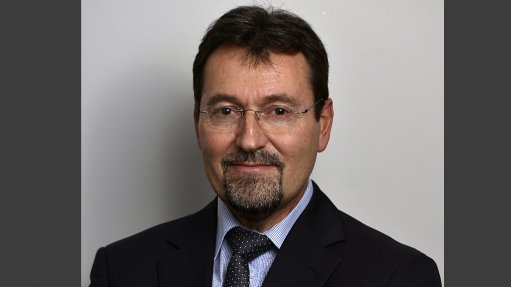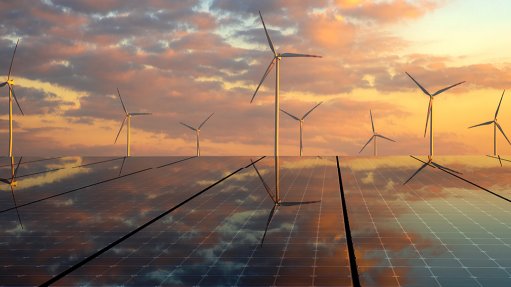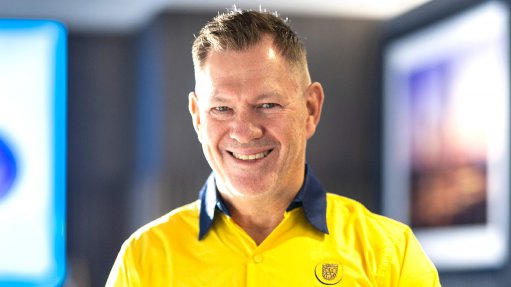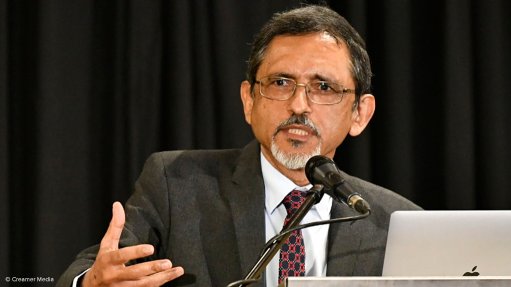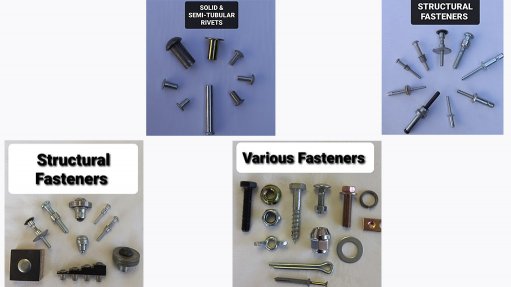Green hydrogen study integrating SADC ahead of trillion dollar market emergence

Sasscol executive director Dr Jane Olwoch interviewed by Engineering News & Mining Weekly’s Martin Creamer. Video: Darlene Creamer.
JOHANNESBURG (miningweekly.com) – A German-funded project to develop a green hydrogen atlas across Southern Africa is integrating the Southern African Development Community (SADC) region ahead of the projected opening up of a trillion dollar market going into the future.
Funded €5.7-million by the Germany Federal Ministry of Education and Research (BMBF), the Green Hydrogen Atlas-Africa project is also placing Southern Africa on the road to contributing meaningfully to global sustainable development goals. (Also watch attached Creamer Media video.)
Southern African Science Service Centre for Climate Change and Adaptive Land Management (Sasscal), which has been turned into Southern Africa’s implementation organisation for the promotion of the Paris Agreement and the reduction of greenhouse gas emissions, is looking with conviction to the day when green hydrogen is in widespread use across SADC countries and the world as part of the global fight against climate change. Sasscol is committed to the successful implementation of this project in 11 SADC countries.
“We’re moving really fast,” Sasscal executive director Dr Jane Olwoch commented to Engineering News & Mining Weekly in a Zoom interview, in which she described the green hydrogen atlas project as the starting point of a process to firm up data and validate green hydrogen sweet spots. This is expected to be followed by the building of a pilot plant that is able to demonstrate the competitiveness of Southern African green hydrogen generation ahead of commercialisation.
Since the programme was launched in Germany in June, a regional technical committee with high-level technical know-how in renewable energy, climate expertise, water resources and socioeconomics has been established. Online engagement with SADC countries is at an advanced stage and on the horizon are:
- the introduction of a post-graduate course in green hydrogen to advance academic sustainability in the region; and
- a visit next year by 15 young scientists to Germany as part of a “seeing is believing” green hydrogen experience.
Sasscal has engaged online with ten SADC countries, including Namibia, Angola, South Africa, Zambia, Botswana, Zimbabwe and Eswatini. Namibia and South Africa have established national green hydrogen structures, with the South African team made up of:
- Dr Rebecca Maserumule, chief director: hydrogen and energy, Department of Science and Innovation (DSI);
- Professor Timothy Dube of the University of the Western Cape;
- Dr Darija Susac, research and technology development manager for fuel cells and electrolysers and key programme manager, Hydrogen South Africa (HySA) Catalysis, DSI Centre of Competency, University of Cape Town;
- Crescent Mushwana, Energy Systems, Council for Scientific and Industrial Research (CSIR) Energy Centre;
- Dr Minesh Bipath, of the South African National Energy Development Institute, who is leading the hydrogen road map work for South Africa;
- Nomthandazo Mabena of the CSIR, who is working in battery storage technologies and fuel cells;
- Thomas Roos, a senior CSIR researcher, who has been leading CSIR work on green hydrogen export opportunities for South Africa; and
- Dr Dmitri Bessarabov of North-West University, who leads HySA Infrastructure in South Africa, under the DSI.
“The green hydrogen export market potential is much larger than the local green electricity market,” Roos stated in the Hydrogen, Fuel Cells & the Green Economy feature in this week’s Engineering News & Mining Weekly.
“Renewable projects built for hydrogen production might even be a way for South Africa to subsidise the strengthening of its physical transmission grid, reducing the cost to the fiscus or existing electricity consumers,” Roos added.
In the same feature, Bessarabov stated: “Water electrolysis can be used to produce hydrogen gas on a large scale. This hydrogen can be stored in different forms and subsequently used in various sectors.”
HySA Infrastructure is leading research and development efforts in South Africa in water electrolysis, based on polymer electrolyte membrane (PEM) electrolysis technology, in which deionised water is spilt into hydrogen and oxygen on the application of an electric current.
Oxygen and protons are generated at the anode that contains iridium-based electrocatalyst. Iridium is a platinum group metal (PGM). At the cathode, the protons that pass through the PEM are reduced by electrons to form hydrogen gas at a platinum-based electrocatalyst.
“Given the fact that the global water volume is estimated to be around 1.4 × 109 km3, hydrogen could be seen as an almost everlasting resource,” Bessarabov added.
In the same feature, venture capital company AP Ventures said: “As a renewable energy-rich country, South Africa has the potential to be a leading global source of low-cost green hydrogen, which offers the exciting economic opportunity to create a long-lasting sustainable industry powered by PGMs, both domestically and internationally.”
AP Ventures described hydrogen as providing domestic energy resilience, creating new high-technology jobs and providing a tangible route to decarbonise at residential and industrial levels.
“Hydrogen offers the opportunity to unlock investment into South Africa and create employment plus a competitive export market. Liquid organic hydrogen carrier technology is a key enabler to link the potential of South African low-cost green hydrogen production, both with domestic demand and to international markets. Recognising this valuable opportunity, we and our investors are working to make the hydrogen economy a reality both in South Africa and worldwide,” stated AP Ventures, the investors of which are the Public Investment Corporation of South Africa, Anglo American Platinum, Mitsubishi Corporation, the Toyota-linked Mirai Creation Fund and Plastic Omnium.
Superior Pressure Solutions (Spress) MD Dawie Strauss stated: “We believe that hydrogen, as an alternative energy source, could change the landscape of the African market, which will lead to cost savings for our clients and contribute to making our continent greener.” Spress is a pressure equipment specialist, which has introduced hydrogen technology to the African market from German high-pressure systems supplier Maximator.
It was also highlighted in the feature that biogenic fraction of municipal solid waste is being used as a renewable feedstock to produce hydrogen at the low cost of at less than $2/kg. This is being done by global renewable energy company SG H2 Energy, part of the Solena Group, which is represented in South Africa by Fuel Cells Africa, whose CEO is Robert van der Merwe. Solena’s technology converts municipal and agricultural waste into a biosynthetic gas, which is used to produce hydrogen, in response to the critical issue of global warming and waste pollution. Fuel Cells Africa reported the finding of the Lawrence Berkley National Laboratory that for every 1 t of hydrogen produced, Solena’s process displaces 23 t to 31 t of carbon dioxide, 13 t to 19 t less than other green hydrogen production processes. According to the draft State of Waste Report published in 2018, South Africa generated 52-million tonnes of general waste, of which 40% was recycled, with the remainder landfilled.
SOUTHERN AFRICA’S YOUNG POPULATION TO BENEFIT
“Africa and Southern Africa have growing populations, young people who are hungry for knowledge, technology and know-how, and this project puts us into this top technology, knowledge and information category. It’s really exciting for me because it’s young people who will really sustain the project that we’re taking steps to develop,” said Olwoch.
The Green Hydrogen Atlas-Africa project was officially launched on June 10, when Germany’s Parliamentary State Secretary Thomas Rachel gave the go-ahead for BMBF’s financial support for the project, which is aimed at strengthening and supporting the region’s capacity for a viable hydrogen economy. The immediate outcome of the project will be an interactive atlas, showing green hydrogen sweet spots.
The success of this, Olwoch stated, can only be realised through strong partnerships between nations that are otherwise separated by many factors, such as physical barriers, and social and economic factors.
Sasscol, which has identified the SADC Centre for Renewable Energy and Energy Efficiency (Sacreee) as a key player to this implementation, has signed a memorandum of understanding with Sacreee, which is helping to strengthen the climate change and energy nexus in the region.
PRIVATE SECTOR
The private sector will be engaged and companies are being approached to join Sasscol.
“We’re taking steps to provide the evidence of Southern Africa’s potential,” said Olwoch.
BMBF energy and green hydrogen technology head Dr Christoph Roevekamp has described SADC as being well positioned as a potential exporter of green hydrogen into a trillion dollar market.
“If we look on the global level, we see that there is a world market for green hydrogen and also for its derivatives, such as ammonia and methanol. All this happened much faster than many people expected so green hydrogen will be able to be produced at the same cost as fossil or blue hydrogen, and this could be achieved in the next two or three years. Therefore, I think the timing of our Green Hydrogen Atlas-Africa is right and the initial outcome from the atlas will provide evidence-based information for policy-makers, investors, companies and researchers,” Roevekamp said.
Institute of Energy and Climate Research head technoeconomic system analysis Professor Dr Detlef Stolten made the point during last month’s workshop that hydrogen being able to power fuel cells will increase demand for platinum mined in the SADC region. South Africa and Zimbabwe host close to 90% of the world’s known PGMs.
On the legislative framework required for green hydrogen to be developed, Sacreee executive director Kudakwashe Ndhlukula has stated that the Sacreee, besides providing technical inputs, also has convening powers to bring in the governments of the region and also to take the initiative to the governments, so that there is total buy-in.
Activities are being aligned towards developing SADC into an industrialised region, with renewable energy and green hydrogen identified as opportunities to realise the industrialisation goal.
The second partner in Africa is the West African Science Service Centre for Climate Change and Adaptive Land Management.
Comments
Press Office
Announcements
What's On
Subscribe to improve your user experience...
Option 1 (equivalent of R125 a month):
Receive a weekly copy of Creamer Media's Engineering News & Mining Weekly magazine
(print copy for those in South Africa and e-magazine for those outside of South Africa)
Receive daily email newsletters
Access to full search results
Access archive of magazine back copies
Access to Projects in Progress
Access to ONE Research Report of your choice in PDF format
Option 2 (equivalent of R375 a month):
All benefits from Option 1
PLUS
Access to Creamer Media's Research Channel Africa for ALL Research Reports, in PDF format, on various industrial and mining sectors
including Electricity; Water; Energy Transition; Hydrogen; Roads, Rail and Ports; Coal; Gold; Platinum; Battery Metals; etc.
Already a subscriber?
Forgotten your password?
Receive weekly copy of Creamer Media's Engineering News & Mining Weekly magazine (print copy for those in South Africa and e-magazine for those outside of South Africa)
➕
Recieve daily email newsletters
➕
Access to full search results
➕
Access archive of magazine back copies
➕
Access to Projects in Progress
➕
Access to ONE Research Report of your choice in PDF format
RESEARCH CHANNEL AFRICA
R4500 (equivalent of R375 a month)
SUBSCRIBEAll benefits from Option 1
➕
Access to Creamer Media's Research Channel Africa for ALL Research Reports on various industrial and mining sectors, in PDF format, including on:
Electricity
➕
Water
➕
Energy Transition
➕
Hydrogen
➕
Roads, Rail and Ports
➕
Coal
➕
Gold
➕
Platinum
➕
Battery Metals
➕
etc.
Receive all benefits from Option 1 or Option 2 delivered to numerous people at your company
➕
Multiple User names and Passwords for simultaneous log-ins
➕
Intranet integration access to all in your organisation









